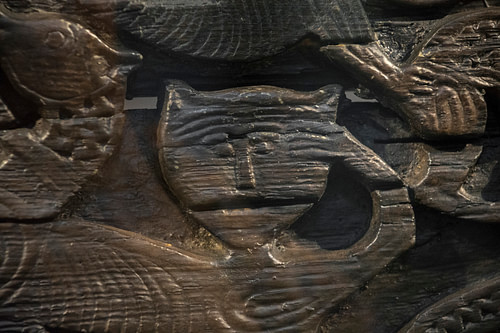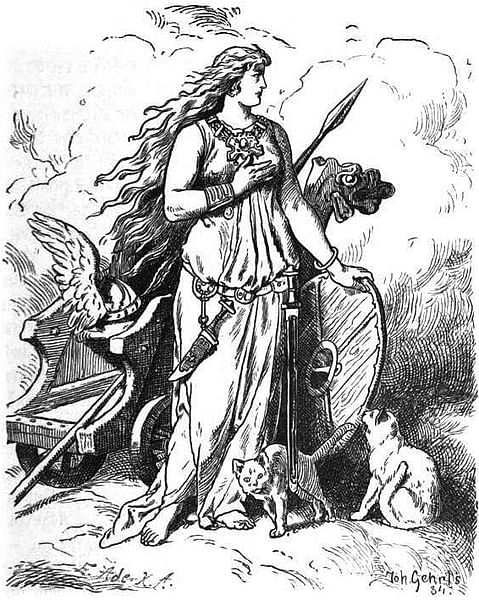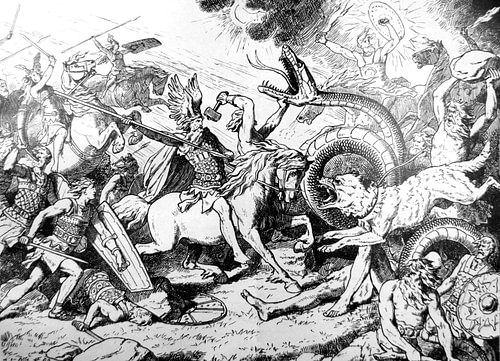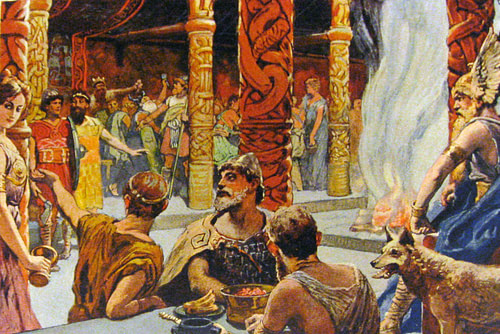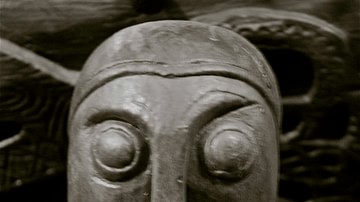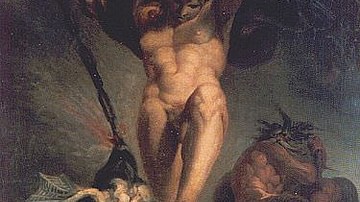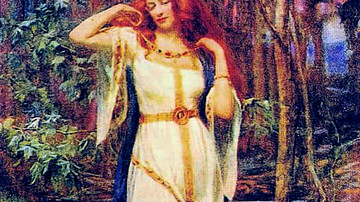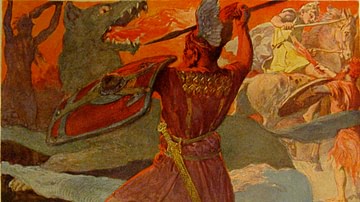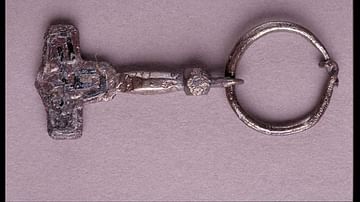Pets were as important to the Norse of the Viking Age (c. 790-1100 CE) as they were to any other culture, past or present. The Vikings kept dogs and cats as pets and both feature in Norse religious iconography and literature. The Norse also kept pet bears and birds, such as the falcon, hawk, and the peacock.
Although it may be hard to imagine a Viking chief bringing his favorite dog or cat along on a raid, recent genetic studies point to precisely such a scenario as it is now thought that Vikings transported cats and dogs on their raids on foreign shores and that these were kept as both working animals and pets in Norse households.
Cats in Norse Mythology
Cats were the favorite animal of the fertility goddess Freyja, who was also the goddess of love and luck. Freyja's chariot was pulled by cats, specifically the skogkatt (Norwegian Forest Cat), which is larger and more powerful than most domesticated housecats. The association of cats with Freyja in her role as goddess of luck and chance, able to tell the future and shape one's destiny, has to do with the nature of the cat itself: it was considered as unpredictable as life itself.
Even though cats were sacred to Freyja, or at least favored by her, they were sacrificed in rituals and their fur used in lining gloves and other apparel but, at the same time, it was considered bad luck to kill a cat. According to mythologist and scholar Jakob Grimm, “when a bride goes to the wedding in fine weather, they say `she has fed the cat well', not offended the favorite of the love goddess” (Chapter 13, p. 14). Treating cats well guaranteed similar treatment of a human by the goddess.
Even so, it is clear that cats were skinned and used for clothing at the same time that they were considered pets and important working animals who controlled the rodent population. Further, they appear as spirit animals, divine guides, and mediums for the volva (seeress) who interpreted the will of the gods for the community or traveled from town to town telling people's fortunes and making predictions. Scholar H.R. Ellis Davidson writes:
The link between cats and the goddess [Freyja] has not been satisfactorily explained, but the gloves made of cat-skin, white and furry inside, mentioned in the Greenland account, suggests that cats were among the animal spirits which would aid the volva on her supernatural journey. (Gods and Myths, 120)
The account Davidson references is from the Eyrbyggja Saga and concerns a famine in Greenland. The head farmer of a community is asked to consult a volva named Thorbjorg on when the famine might end. When she arrives at his house, a description is given:
Around her neck, she had glass beads and, on her head, she wore a hood of black lambskin with an inner lining of white catskin. She carried a staff in her hand. On it was a knob, decorated with brass and set with stones. Attached to her belt was a large skin purse where she kept the charms she needed for her craft. On her feet she wore calfskin shoes with the hair still on them. They had long, tough laces with large tin knobs on the ends. Her gloves were catskin with white fur inside. (Sommerville & McDonald, 54).
The volva in this story is unable to see the future until Gudrid Thorbjorndottir, the future explorer of North America, sings mystical chants which soothe the spirits and allow Thorbjorg her vision. She predicts that the famine will end soon and also that Gudrid would go on to lead a distinguished life (which she did, traveling to Iceland, North America, and finally Rome). The role cats play in the volva's work in this account is unspecified but it is thought that the objects she carried and items of apparel she wore all had mystical significance.
Besides cats as Freyja's favorite and the mystical guides of the seeress, they also feature in the myth of Fenrir, the great wolf who will break free at Ragnarok, the end of the world and twilight of the gods, and in the tale of Thor's contest at the castle of the giant Utgarda-Loki. In the first story, Fenrir breaks the first two fetters the gods place him in, and the gods then go to the dwarves, makers of magical items, and bring back a cord named Gleipnir (“open one”) made from the sound of a cat walking, the beard of a woman, the roots of the mountains, the breath of a fish, and the spittle of a bird or, as scholar Rudolf Simek notes, “from everything that does not exist” (113). This cord, though incredibly light, is strong enough to hold Fenrir.
In the second story, Thor is challenged by Utgarda-Loki to perform three feats which will show his worth. The second of these challenges is to lift a large gray cat off the floor. Thor thinks this will be simple but is only able to lift the cat so that one paw is in the air. Thor fails at all three tasks but is later told by the giant that magic had transformed everything and none of the challenges had actually been what they seemed. The gray cat was actually the Midgard serpent which encircles the world.
Cats in daily life
The cat was no doubt imported to Scandinavia through trade with either the Phoenicians or Romans and the first cats to make the trip were probably smuggled out of Egypt. The Egyptians had a strict policy regarding the sale and transport of cats from their country: it was prohibited. Still, that did not stop traders from smuggling cats on board their ship in Alexandria and carrying them off to other lands. Evolutionary geneticist Eva-Maria Geigl notes the same maternal DNA found in cats from ancient Egypt is present in those found at a Viking site in northern Germany dated to the 8th and 11th centuries CE (Cats Sailed with Vikings, 3).
In Norse everyday life, cats were an important aspect of the household who controlled rats and mice and were also carried aboard Viking ships. There is archaeological and genetic evidence of Vikings carrying cats to Greenland, and it is possible, though not proven, that cats – as well as dogs - were also aboard the Viking ships of Leif Erikson when he landed at Vinland (Newfoundland, Canada) in the New World.
Cats, then, played an integral part in the lives of the people of Scandinavia whether they stayed home on their farms or went raiding as Vikings. The dog, however, was just as important and is also featured in Norse myths as well as serving as faithful companions and guides to the afterlife.
Dogs in Norse mythology
The best-known dog from Norse mythology is Garm (also given as Garmr), who, according to mythologist Snorri Sturluson (1179-1241 CE), guarded the gates of the afterlife realm of Hel. Garm is said to have kept the souls of the dead safely behind Hel's walls while also keeping the living from trespassing in trying to bring a soul back to the land of the living. Later scholars (such as Rudolf Simek and John Lindow) dispute Snorri's interpretation, however, pointing out that the dog who guards Hel has no name and that Garm is identical to the great wolf Fenrir as both are loosed at Ragnarok and both kill the war-god Tyr who sacrificed his hand to bind Fenrir.
At the same time, however, Garm is called “best of hounds” by Odin in the Grimnismal section of the Poetic Edda when he lists the best things in all the cosmological realms. It seems unlikely he would refer to Garm this way if Garm were another name for Fenrir. Even so, Garm is repeatedly referred to using the same imagery and phrasing used to describe Fenrir.
Whether Garm is or is not the guardian of Hel, dogs were closely associated with the gods and the afterlife. The great Icelandic sagas mention dogs accompanying their masters to Valhalla after death. The dog acted as a kind of psychopomp, guiding the soul from the realm of life to the land beyond death. Scholar Anne-Sofie Graslund comments on this:
The dog is both nature and culture, both good and evil, and stands between this world and the other world. The dogs could bear the souls through the border area from the land of the living to the land of the dead…but dogs were not only conductors to the realm of the dead, they also acted as guards at the entrance of the underworld so that the living could not enter and the dead could not leave. (171)
More dog remains have been found in Scandinavian burial sites than in those of any other culture. Graslund notes how they obviously played an important sacrificial role in funerary rites but also how often they are depicted, sometimes in great detail, in rock carvings which show hunting scenes and also ritual ceremonies (167). This is hardly surprising since, according to Adam of Bremen (c. 1050 - c. 1085 CE), dogs were among the sacrifices at the Temple of Uppsala in Sweden dedicated to Odin, Thor, and Freyr, the fertility god and brother of Freyja. H.R. Ellis Davidson notes:
Dog skeletons, sometimes several at a time, are found along with those of horses and cattle in the great Scandinavian ship-burials of the Viking Age, and both large hunting dogs and smaller breeds in individual graves…In Scandinavian myth and legend the dog is the guardian of the underworld and one reason for putting a dog into a grave might be to provide a guide for the dead. (Myths and Symbols, 57)
Mother Goddess figures, or protective female deities in general, are often depicted with a dog, and in Norse mythology, they are linked to the powerful goddess Frigg, Odin's consort. Although dogs are not explicitly referenced as favorites of Frigg, she is sometimes depicted in a chariot drawn by dogs. It may be that Frigg's association with dogs is a later development intended to further differentiate her from Freyja and her cat-drawn chariot but utilizing similar imagery. There are so many similarities between the two goddesses that scholars believe they were once a single deity.
Dogs in Daily Life
Dogs were not only honored through mythological and spiritual connections, however, but were an important part of everyday life in Scandinavia. Dogs were companions as well as working animals, and farmers who could afford it would keep both hunting and herd dogs.
Hunting dog breeds were:
- Norwegian Elkhound
- Swedish Elkhound
- Karelian Bear Dog
- Finnish Spitz Dog
- Danish bird Dog
- Norwegian Lundehund
Herd dog breeds were:
- Lapphund
- Lapp Reindeer Dog
- Vallhund
- Icelandic Sheep Dog
- Norwegian Buhund (Source: Viking Answer Lady)
These dogs were highly valued and expensive to train and keep and so became status symbols among the Norse. The more dogs one had, the greater one's show of wealth and success. Dogs were imported to Iceland as evidenced by excavations of graves which contain full skeletons of dogs and they were buried both with their masters and on their own. The importance of the dog to its master is emphasized by the inclusion of dogs in Odin's great hall of Valhalla in the afterlife. It is not only the soul of the warrior that lives on in the hall but also that of his dog.
Other Animals
Bears, hawks, and falcons were also kept as pets. Bears were fairly common pets but hawks and falcons were only kept by nobility and wealthy merchants and the same was true of peacocks. Brown bear cubs would be taken when young and raised by the people of a home to be fully domesticated. These bears were then known as “house bears” (Viking Answer Lady, 10). In time, these bears became more of a nuisance than anything else and importing them to Iceland was forbidden by law.
Large fines were levied on people who allowed their house bear to get loose and damage someone else's property (Viking Answer Lady, 10). Wild bears were sacrificed just as dogs, horses, and other animals but it seems house bears were given a burial. Prior to interment, the bear was eaten and only its bones were placed in the grave (Jennbert, 147). Whether this practice applied only to house bears or bears in general is unknown.
Polar bears were also domesticated and scholar Sveinbjorn Rafnsson notes how Norse settlements in Iceland and Greenland were able to export exotic valuables to Europe, including the polar bear (Sawyer, 132). Whether the Norse domesticated other wild animals as pets is unknown but certainly possible.
Conclusion
Primarily, however, the Norse of the Viking Age shared their homes, beds, ships, and days with cats and dogs just as people do in the modern day. Dogs had collars which sometimes identified them or their owners and leashes and leads were used as they are today. The unpredictable cat's association with the goddess of luck and chance emphasizes how little cats have changed from the Viking Age to the present time and the depiction of dogs as faithful companions and partners in adventure shows the same for them. With pets, as with so many other aspects of life, the fundamental differences between the people of the past and those of the present are really quite small.
